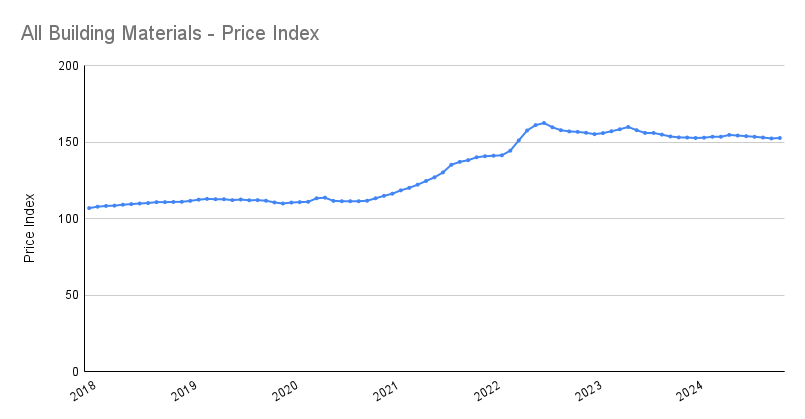Last updated: January 14th 2025
There has been a significant 35% increase in the price of building materials since 2020 with the steel coils Cladco use to manufacture roofing sheets one of the materials affected.

The latest data from the Department for Business and Trade shows a 0.2% rise in the building material price index in November 2024. The first monthly rise in six months after five consecutive months of falling building material prices.
Read on for the latest individual price changes, understand their causes and how they impact the construction sector.
Latest Price Changes
| Price Change Since 2020 (Nov 2020 - Nov 2024) | 12 month Price Change (Nov 2023 - Nov 2024) | Price Change in Last month (Oct 2024 - Nov 2024) | |
| All Materials | 35% | -0.3% | 0.2% |
| New Housing Materials | 34% | 1.3% | 0.3% |
| New 'Other' Materials | 36% | -1.5% | 0.1% |
| Repair and Maintenance Materials | 33% | 0.9% | 0.1% |
* Source: Department for Business and Trade
While there has been a 35% increase in the price of all types of building materials since November 2020, the last 12 months have seen a 0.3% fall in prices.
There was a 0.2% rise in prices in November 2024. The first rise in six months.
Latest Price Trend

* Source: Department for Business and Trade
There was a significant increase in prices through 2021 and into 2022. Prices peaked in July of 2022 and have remained high.
Materials Showing Highest Price Increases (since 2020)
| Price Change Since 2020 (Sep 2020 - Sep 2024) | 12 month Price Change (Sep 2023 - Sep 2024) | |
| Pre-cast concrete products | 59% | 4.8% |
| Plastic pipes and fittings (flexible) | 46% | -3.9% |
| Insulating materials (thermal or acoustic) | 53% | 1.3% |
| Metal Doors & windows | 53% | 2.5% |
| Ready-mixed concrete | 49% | 0.4% |
| Plastic Doors & windows | 42% | -0.2% |
| Concrete reinforcing bars (steel) | 38% | -2.9% |
| Concrete blocks, bricks, tiles & flagstones | 49% | 6.1% |
| Kitchen furniture | 35% | 0.8% |
| Builders woodwork | 33% | -0.4% |
* Source: Department for Business and Trade
The Effect on the Construction Industry

PROPERTY DEVELOPERS
The rise in building material prices in the UK is having a significant impact on property developers, making it more expensive to build new homes and commercial properties. This is impacting profitability and forcing developers to make difficult choices about their projects.
Some of the key ways in which the rise in building material prices is affecting property developers include:
- Reduced profitability:
The increased cost of building materials is reducing profitability for developers. This is because they are still selling new homes and commercial properties at the same prices, but their costs are now higher. - Delayed projects:
Some developers are delaying projects due to the rise in building material prices. This is because they are waiting for prices to come down or because they are struggling to find the finance to cover the increased costs.
- Scrapped projects:
Home developers are even scrapping projects altogether due to the rise in building material prices. This is because they are no longer viable due to the increased costs.
The rise in prices is also having a knock-on effect on UK house prices. It’s making it more expensive to buy a new home, as developers are passing on the increased costs to buyers. This is reducing affordability and making it harder for people to get on the property ladder.
Property developers are facing a challenging period, as they try to balance the need to build new homes and commercial properties with rising costs.
HOME RENOVATORS
The increase in costs is making it more expensive for homeowners to undertake renovations, and it is also leading to delays in projects. In some cases, homeowners are having to abandon their plans altogether.
For homeowners who are planning a renovation, it is important to factor in the potential for increased costs and delays. It is also important to get quotes from multiple contractors before starting any work.
Tips:
Here are some tips for homeowners who are planning a renovation:
- Be flexible with your plans:
If you are able to delay your project, you may be able to save money by waiting for prices to come down. - Consider using alternative materials:
There are a number of alternative materials available that are often cheaper than traditional materials. - Get quotes from multiple contractors:
This will help you to get the best possible price for your project. - Be prepared for delays:
It is important to be realistic about the potential for delays caused by shortages of materials.
PROJECT FINANCING
The rise in building material prices in the UK is having a significant impact on the financing of building projects. High costs have made building projects more expensive. This can make it difficult for developers to secure financing, as lenders may be reluctant to lend money on projects that are at risk of overrunning their budgets.
Tips:
Some tips for developers looking to secure financing include:
- Be organised:
Ask your broker what they need and give them exactly what they ask for - not what you think fits best! - Focus on getting your ducks in a row:
Provide clear copies of the documents required to put your application on the front foot. - Diversify your suppliers:
To mitigate the impact of rising prices, consider sourcing materials from a variety of suppliers. This will give you the flexibility to opt for more cost-effective options if one supplier increases their prices.
“The construction industry is particularly susceptible to changes in commodity prices: steel, concrete, wood, or any other essential material, so if prices soar, it hits the profit margins of construction companies hard.
And a delay in getting these resources can lead to project delays adding to the cost – extending the timeline of the project, meaning you have to pay those higher labour costs for longer and work around contracts etc.
What’s compounded this is we’ve seen interest rates rise too, meaning funding is getting more expensive.
If the developer is selling the project on completion, it’s also more difficult for buyers to rustle up a deposit and a mortgage in the current climate.
All of these squeeze margins and decrease profits for the developers. Unless you are very experienced and can accurately forecast these things they can quite quickly get out of control and cause big issues.”

BUILDING COMPANIES
Rising prices have had a significant impact on specialist building companies.
- Reduced margins:
The higher cost of materials is making it more expensive for building companies to complete projects. This is putting pressure on their margins and making it difficult to remain competitive. - Reduced demand:
Some customers may be deterred from starting building work due to the increased costs. This could lead to a reduction in demand for specialist building companies. - Delays:
The ongoing shortage of building materials is also causing delays to projects. This is frustrating for customers and can lead to additional costs for building companies. - Difficulty quoting for projects:
It is becoming more difficult for building companies to quote for projects, as the cost of materials is fluctuating so much. This can lead to disputes with customers if the cost of materials increases after a quote has been given.
“Building material price increases have greatly affected our company. Material prices can be as much as 30% of the overall build cost. These have gone up since 2021 around 30% and with some materials even more.
Timber went up at least 100%+ in 2021. We build thousands of loft conversions which are made from wood, so, this has affected our costs massively. Margins have been squeezed as well. But we have been sensible and made sure we’ve increased everything accordingly to keep the company stable.
In terms of how we navigate the price increases - we simply monitor material prices and labour prices carefully. In turn, we react quickly if necessary and change our quotes.
Material cost are still going up but are more stable now. Labour costs are the current obstacle. But I think these have reached saturation point now as sales overall will fall as less clients can afford to get the work done. I’d hope for a more stable 2024.”

In addition to these challenges, building companies are also facing other challenges such as rising labour costs and fuel prices.
Many companies are struggling to cope with the increased costs and delays. Some companies may be forced to increase their prices or even reduce their workforce.
Tips:
Building companies can taking a number of steps to mitigate the impact of the rise in building material prices, such as:
- Negotiate with suppliers:
Try to negotiate better prices with your suppliers. However, this is becoming increasingly difficult, as suppliers are also facing rising costs. - Source alternative materials:
Look for alternative materials that are more affordable. However, this can be difficult, as there is a shortage of many building materials. - Pass on costs to customers:
Some specialist builders are passing on the increased cost of materials to their customers. However, this can make your company less competitive. - Delay projects:
Some companies are delaying projects until the cost of materials comes down. However, this can lead to lost revenue and damage relationships with customers.
When Will Building Material Prices Come Down?
The cost of building materials remains high due to a mix of challenges. Even though the pandemic has ended, its effects linger. The construction industry still faces a lack of materials and workers, which drives up prices. Some industry experts are saying these issues might continue until 2024.
Brexit has added to the challenges. Though there has been a slight drop in prices in 2023, the industry is grappling with a shortage of workers, new border checks, and changing regulations, all of which contribute to higher costs. It's estimated that the UK construction sector will need 225,000 more workers by 2027 to meet the demand 1., a situation worsened by Brexit as many workers have returned to their home countries. The government is trying to address this by relaxing immigration rules for construction workers, but the problem is far from solved.
Shipping issues have also played a part in the high prices. Although the shortage of shipping containers has improved, global tensions, like the ongoing war in Ukraine, are causing fresh delays.
Lastly, the value of the pound is influencing prices. Its strength depends on many factors like the country's economic policies, inflation rate, and overall economic growth. Unfortunately, it's tough to predict when this situation will improve.
In the near term, it looks like the construction industry will continue to face these cost challenges. Keeping an eye on economic indicators and global events might give us a better idea of when relief may come.
How has Covid-19 Affected Building Materials Prices?

The COVID-19 pandemic had a significant impact on the prices of building materials. The following are some of the reasons why:
- Supply Chain Disruptions:
The pandemic caused closures and delays at factories producing building materials, leading to a decrease in the supply of materials. As homeowners flocked to hardware stores seeking supplies, building supply chains couldn’t keep up. Stricter regulations due to COVID-19 also slowed down delivery times. - Raw Materials Shortages:
The pandemic resulted in factory shutdowns and labour shortages, which led to a significant shortage of raw materials. - Worker Shortages:
The pandemic triggered a worker shortage in the building materials sector, which led to limited availability of products. Factories wanted to increase output, but they couldn’t find workers. During the early stages of the pandemic, many factories lacked the resources needed to cover employee wages and keep their businesses afloat. - Increased Demand:
During the pandemic many consumers invested in building projects with savings accumulated during the pandemic. When lockdown restrictions were eased there was a surge in construction projects, resulting in a surge in the consumption of materials. This has contributed to the vast increase in demand, particularly for already scarce materials such as steel, cement, timber, and electrical components. Demand very quickly outstripped supply….
Overall, the supply of building materials dramatically decreased, and what remained became much more expensive.
How Has Brexit Affected Building Material Prices?

Brexit has had a significant impact on the price of building materials in the UK due to several reasons:
- Supply Chain Disruptions:
Brexit has led to disruptions in supply chains, affecting the availability of raw materials and equipment needed for construction projects. The construction industry has experienced rising expenses for materials and goods imported from the EU. - Border Checks and Delays:
Leaving the European Union has resulted in extra checks and delays at the border, increasing the time to market for materials and subsequently raising prices. - Raw Materials Shortages:
Extra checks and delays at the border have increased the time to market for some raw materials. Labour shortages in many factories are a problem as overseas factory workers have returned home. - Labour Shortages:
Brexit has contributed to a nationwide labour shortage in the UK, as many workers involved in the manufacturing of building materials have left the UK to return to their home countries. This has led to increased costs for construction projects. - Changes in Regulations and Standards:
Brexit has brought about significant changes in regulations and standards governing the construction industry, resulting in additional compliance costs for construction firms.
Overall, the cost of construction materials in the UK increased by around 60% between 2015 and 2022, compared to a 35% increase in the EU over the same period 2..
How Have Global Shipping Disruptions Affected Building Material Prices?
Global shipping disruptions have significantly impacted the price of building materials in the UK A shortage of empty containers coincided with a sharp recovery in global demand post-COVID and has led to a significant rise in shipping costs. These shipping costs are affecting the cost of imported building materials.
How Have Rising Energy Costs Affected Building Material Prices?

Rising energy costs have had a significant impact on the price of building materials in the UK due to several factors:
- Cost of Raw Materials:
As energy costs have risen so has the cost to extract and produce the raw materials used in building materials. - Energy Surcharges:
Energy surcharges are being passed down the supply chain, contributing to increased material costs. - Manufacturing and Shipping Costs:
The surge in energy prices has significantly impacted the cost to manufacture and ship building materials. The production of these materials is an energy-intensive process, and the shipping process requires a substantial amount of fuel.
How Has The Strength of the Pound Affected Building Material Prices?
The strength of the pound significantly impacts the price of building materials in the UK due to the country's reliance on imported goods and services. Approximately 60% of building materials used on UK construction projects are imported, making the industry vulnerable to fluctuations in the strength of the currency 3..
When the value of the pound decreases, the cost of importing construction materials like metal and timber from different parts of the world rises. This can lead to scenarios where commercial projects may run into budgetary issues due to the increased cost of materials.
How Has the War in Ukraine Affected Building Material Prices?

The war in Ukraine has had a significant impact on the price of building materials in the UK due to a variety of interconnected factors:
- Supply Chain Disruptions:
The conflict has caused severe disruptions to global markets for critical raw materials such as steel, iron, nickel, and timber. Russia and Ukraine are significant suppliers of these materials, and the war, coupled with the sanctions imposed on Russia, has disrupted international trade flows. For instance, Russia's Rusal, one of the largest aluminium producers, has been directly affected by sanctions, disrupting about 12% of the world's global aluminium supplies 4.. - Increased Energy Costs:
The war has led to skyrocketing oil and gas prices in Europe, which in turn has increased the cost of materials that use more energy in their manufacturing process. For example, British Steel has cited escalating energy prices as a reason for their price hikes 5.. Steel construction materials are particularly affected as they are energy-intensive. - Increased Demand and Shorter Supply:
The war has exacerbated existing supply chain issues caused by factors such as Brexit, the COVID-19 pandemic, and global shipping disruptions. The ncreased demand and shorter supply of building materials is resulting in price increases. - Increased Time to Market:
The conflict has also led to longer wait times, checks, and delays at the border, increasing the time to market for materials and subsequently their cost.
Conclusion
We’ve looked at the significant rise in building materials prices in the UK. From July 2020 to July 2022, there was a 46% surge in material prices. Prices remain high with the past year only seeing a 0.3% fall in prices overall. Specific materials like pre-cast concrete have seen a substantial 59% increase in prices since 2020.
Factors such as global shipping disruptions and geopolitical tensions, especially the war in Ukraine, have been influential in shaping these price trends. Given the UK construction industry's reliance on imports, the strength of the pound remains a pivotal factor in determining material costs. As for the widespread concern regarding when these price hikes will stabilise, industry experts continue to monitor economic and geopolitical indicators, hoping for signs of relief in the near future.
